Chichen Itza is a 1500-year-old Mayan pyramid in Mexico's Yucatan peninsula. The site features three sections with distinct styles and is home to the largest ball court in ancient Mesoamerica. A Sacred Cenote dedicated to the Chac God is also located on the premises, featuring steep vertical sides and a natural steam bath area.


1. Overall Rating (0–10) — 6.0
This photograph captures the playful commercialism of a beachside souvenir shop, where tourist culture is distilled into bold, graphic t-shirts. The composition is candid and slightly cluttered, reflecting the chaotic energy of a retail window display, yet the juxtaposition of the two shirts—each with its own humorous message—creates a subtle narrative about identity and disorientation. While the image effectively conveys the setting, its technical execution and visual clarity hold it back from greater artistic impact.
2. Composition (0–10) — 6.5
The t-shirts are centered and dominate the frame, but reflections in the glass and overlapping elements create visual noise. The price sign on the left provides context but disrupts the balance, pulling attention away from the main subjects.
3. Lighting (0–10) — 5.5
Harsh, direct light from the window creates glare and reflections that obscure parts of the image. The lighting is functional but lacks the softness or directionality needed to enhance mood or depth.
4. Color & Tone (0–10) — 6.0
The bright orange, red, and blue of the t-shirt designs stand out against the white fabric, creating a vibrant, eye-catching contrast. However, the overall tone is somewhat flat due to the overexposed highlights and lack of tonal variation.
5. Creativity (0–10) — 6.5
The image captures a slice of tourist culture with a tongue-in-cheek sensibility, using the shirts' slogans to suggest themes of navigation and identity. The humor and cultural specificity lend it a unique character, though the approach is more observational than conceptual.
6. Technical Quality (0–10) — 6.0
The focus is generally sharp on the shirts, but the reflections and slight overexposure reduce overall clarity. The image appears to be taken in daylight without careful control of exposure or composition.
7. Emotional Impact (0–10) — 5.5
The photograph evokes a sense of familiarity and mild amusement, tapping into the shared experience of travel souvenirs. However, the emotional resonance is limited by the lack of personal connection or deeper narrative, leaving the viewer as a passive observer rather than an engaged participant.
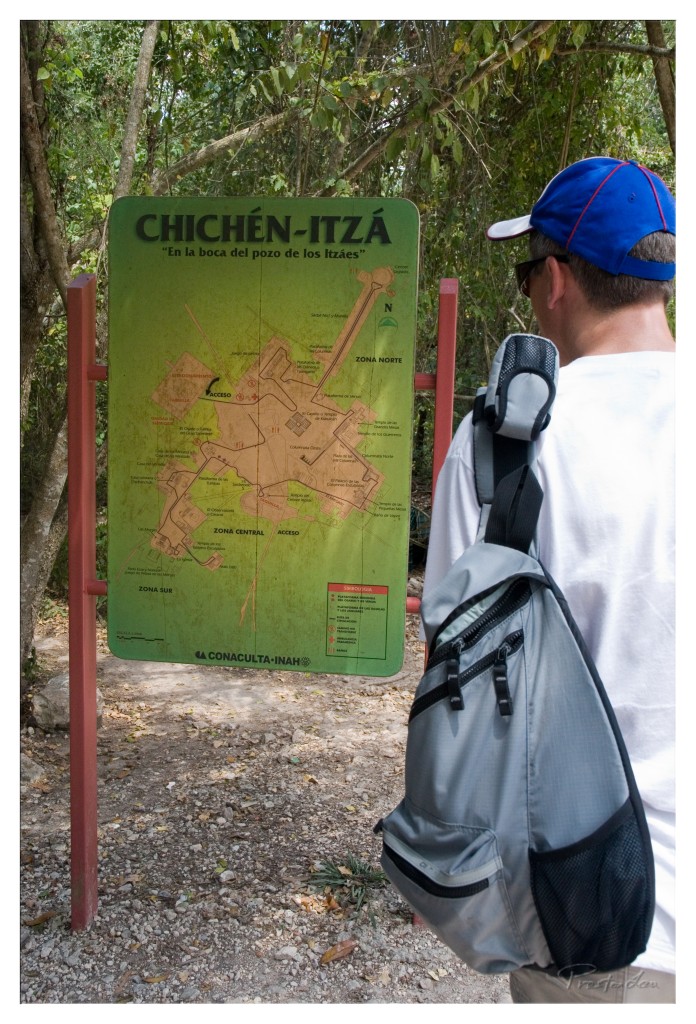

1. Overall Rating (0–10) — 6.0
This image captures a quiet moment of exploration at Chichén Itzá, where a visitor pauses to study the site map amidst lush greenery. The composition balances human presence with cultural context, grounding the scene in both place and purpose. While the moment feels authentic, the flat lighting and somewhat cluttered framing prevent it from achieving a more compelling visual resonance.
2. Composition (0–10) — 6.0
The subject is placed off-center, creating a natural leading line toward the map, but the intrusion of the backpack and the tight framing reduce visual harmony.
3. Lighting (0–10) — 5.5
Natural daylight illuminates the scene evenly, but the overhead sun creates flat shadows and a lack of atmospheric depth, diminishing the richness of the surrounding foliage.
4. Color & Tone (0–10) — 5.5
The green of the sign and trees dominates, but the colors appear muted and slightly washed out, with a lack of vibrancy that softens the contrast between natural and man-made elements.
5. Creativity (0–10) — 5.0
The image functions as a straightforward travel document, capturing a common tourist moment without a distinct narrative or stylistic interpretation.
6. Technical Quality (0–10) — 7.0
The image is sharp and well-focused, particularly on the map and the man’s figure, with clear detail in the textures of the backpack and foliage.
7. Emotional Impact (0–10) — 5.0
The scene evokes a sense of curiosity and quiet anticipation, but the emotional distance created by the viewer’s perspective and neutral lighting limits deeper connection.
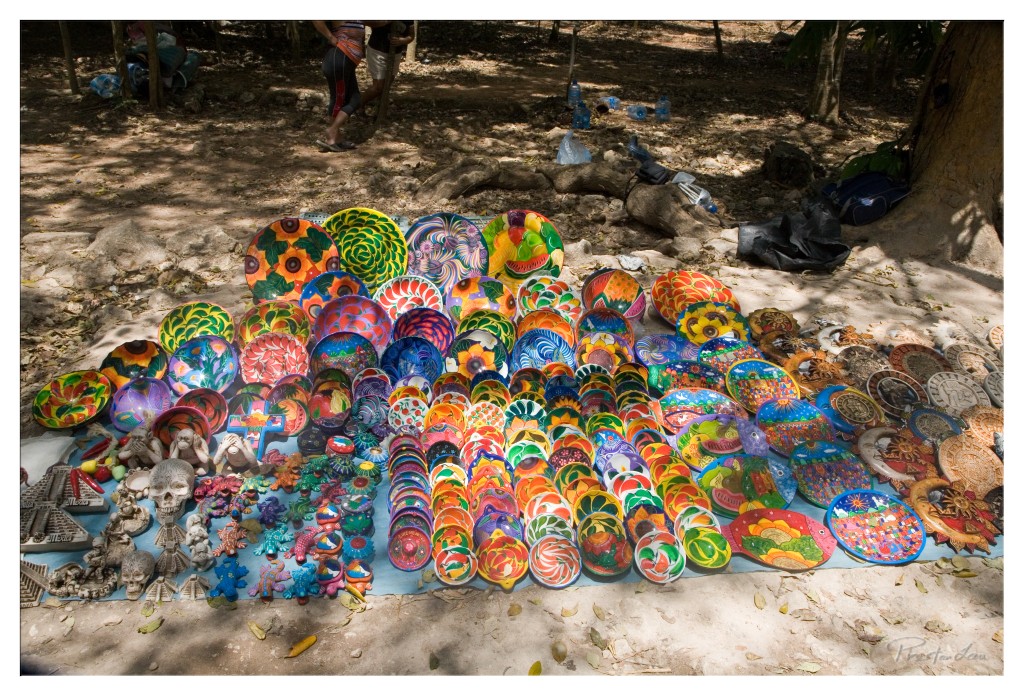

1. Overall Rating (0–10) — 7.0
This photograph bursts with the vibrant energy of a roadside artisan market, where hand-painted pottery and souvenirs spill across the earth like a celebration of color and craft. The vivid patterns and textures create an immediate sense of cultural richness and place, though the composition’s cluttered arrangement risks overwhelming the viewer. A more deliberate framing could elevate the visual harmony, but as a snapshot of life and tradition, it remains compelling and evocative.
2. Composition (0–10) — 6.0
The frame is densely packed with objects, creating a visually busy foreground that draws the eye but lacks clear focal hierarchy. The arrangement feels natural rather than curated, with the scattered pottery and figurines creating a sense of abundance, yet reducing compositional clarity.
3. Lighting (0–10) — 6.5
Dappled sunlight filters through the trees, casting soft shadows and creating a dynamic interplay of light and shade across the colorful plates. While the lighting enhances texture and depth, it also introduces some uneven exposure, with parts of the scene underexposed and others slightly washed out.
4. Color & Tone (0–10) — 9.0
The palette is a dazzling array of saturated hues—fiery oranges, electric blues, and lush greens—each plate a canvas of intricate, handcrafted design. The contrast between the vibrant ceramics and the muted, earthy tones of the ground and background heightens the visual impact, making the colors pop with lively intensity.
5. Creativity (0–10) — 7.5
The image captures a moment rich in cultural authenticity and artisanal detail, transforming a simple market display into a celebration of human creativity. The photographer’s choice to include the surrounding environment and a faint human presence adds narrative depth, suggesting a story beyond the objects themselves.
6. Technical Quality (0–10) — 7.5
The image is sharp and detailed, with clear focus on the foreground elements. The resolution effectively captures the fine patterns on the pottery, and the overall exposure is well-balanced despite the challenging natural lighting conditions.
7. Emotional Impact (0–10) — 7.0
There’s a warmth and joy in the image, evoking a sense of discovery and connection to a place where tradition meets commerce. The viewer is invited to appreciate not just the beauty of the crafts, but the life and labor behind them, though the lack of a central subject limits the emotional intimacy.
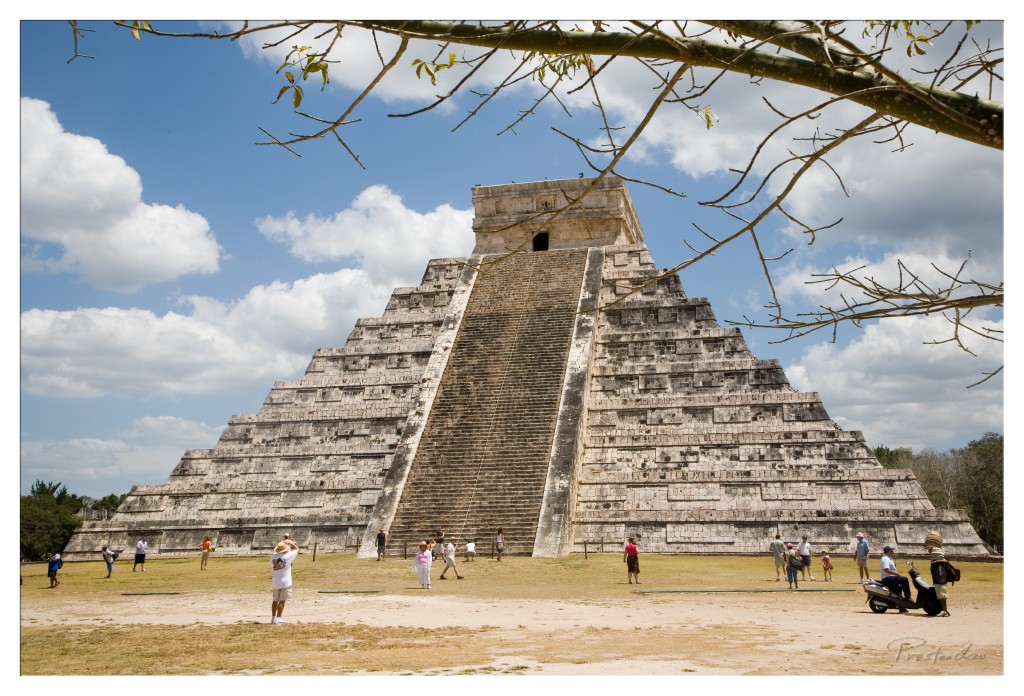

1. Overall Rating (0–10) — 7.0
This image captures the grandeur of Chichen Itza’s El Castillo with a sense of scale and historical weight, enhanced by the framing of overhanging branches that lend a natural, almost reverent border to the scene. The bright daylight and scattered tourists emphasize the site’s accessibility and cultural resonance, though the composition’s busyness slightly undermines the monument’s solemnity. The photograph balances documentation and artistry, offering a vivid snapshot of a world-renowned landmark in its present-day context.
2. Composition (0–10) — 6.5
The pyramid is centered and dominates the frame, creating a strong focal point, but the inclusion of foreground branches and scattered visitors introduces visual clutter. The framing adds depth and context, yet the composition feels slightly unbalanced due to the asymmetrical placement of people and the distracting lower-left edge.
3. Lighting (0–10) — 8.0
Bright, natural daylight enhances the texture of the stone and highlights the pyramid’s stepped structure. The sunlight creates subtle shadows that accentuate the monument’s form, while the dynamic sky adds contrast and visual interest.
4. Color & Tone (0–10) — 7.0
The palette is vibrant, with the deep blue sky and white clouds creating a striking contrast against the beige stone. The warm tones of the sand and earth ground the image, though the overall saturation is moderate, preserving a naturalistic feel.
5. Creativity (0–10) — 6.5
The use of natural framing with tree branches adds an organic, cinematic quality, subtly guiding the viewer’s eye toward the pyramid. While the subject is iconic, the creative choice to include both the ancient and the contemporary—tourists and modern scooters—adds a layer of narrative that feels both grounded and thoughtfully observed.
6. Technical Quality (0–10) — 8.0
The image is sharp and well-focused, with clear detail across the pyramid’s surface and foreground elements. The exposure is balanced, with no significant overexposed or underexposed areas, indicating strong technical execution.
7. Emotional Impact (0–10) — 6.0
The photograph evokes a sense of awe and reverence for the ancient world, yet the presence of tourists and modern life tempers the emotional weight. It invites contemplation on time, legacy, and the intersection of past and present, though it remains more observational than deeply moving.
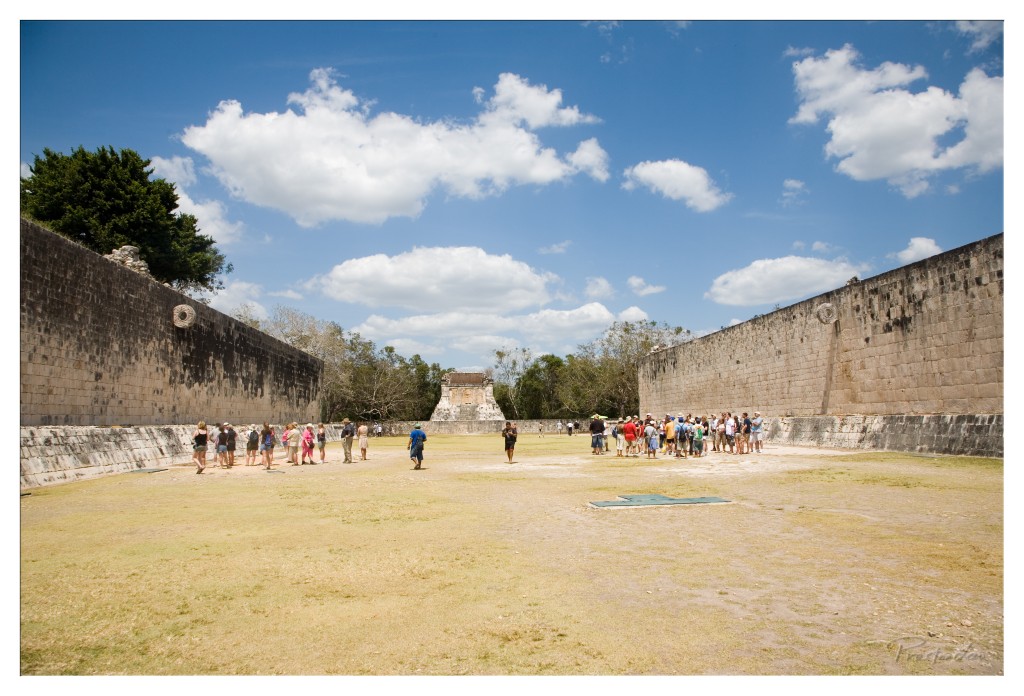

1. Overall Rating (0–10) — 7.0
This photograph captures the expansive grandeur of a Mayan archaeological site under a vibrant sky, evoking a sense of history and scale. The wide perspective emphasizes the monumental architecture and the human presence within it, grounding the ancient stones in the rhythm of modern tourism. While the image conveys a strong sense of place, the composition feels slightly unbalanced, and the lighting, while bright, lacks the dramatic depth to fully elevate the scene.
2. Composition (0–10) — 6.0
The wide-angle framing captures the full breadth of the plaza, but the placement of the tourists and the central structure feels slightly off-center, creating visual tension. The strong horizontal lines of the walls anchor the image, but the empty foreground detracts from the focus on the main subject.
3. Lighting (0–10) — 7.0
The bright daylight enhances the textures of the stone walls and the vivid blue of the sky, while the soft, scattered clouds add depth and contrast. The sun’s high position creates even illumination, though the shadows are minimal, reducing the sense of three-dimensionality.
4. Color & Tone (0–10) — 7.0
The palette is dominated by warm earth tones in the stonework and dry grass, balanced by the cool blues of the sky. The contrast between the warm and cool tones is effective, and the colors feel natural and well-saturated without appearing overprocessed.
5. Creativity (0–10) — 6.0
The image functions as a strong documentary capture, emphasizing the site’s scale and accessibility. However, it lacks a distinctive artistic vision or narrative twist—its strength lies in clarity rather than originality.
6. Technical Quality (0–10) — 8.0
The image is sharp and well-exposed, with clean details in both the foreground and background. The depth of field is appropriately managed, keeping the key elements in focus across the wide frame.
7. Emotional Impact (0–10) — 6.5
The photograph evokes a sense of awe and curiosity, inviting the viewer to imagine the site’s ancient past. While the presence of tourists tempers the sense of mystery, the vastness of the space and the clear sky still inspire contemplation.
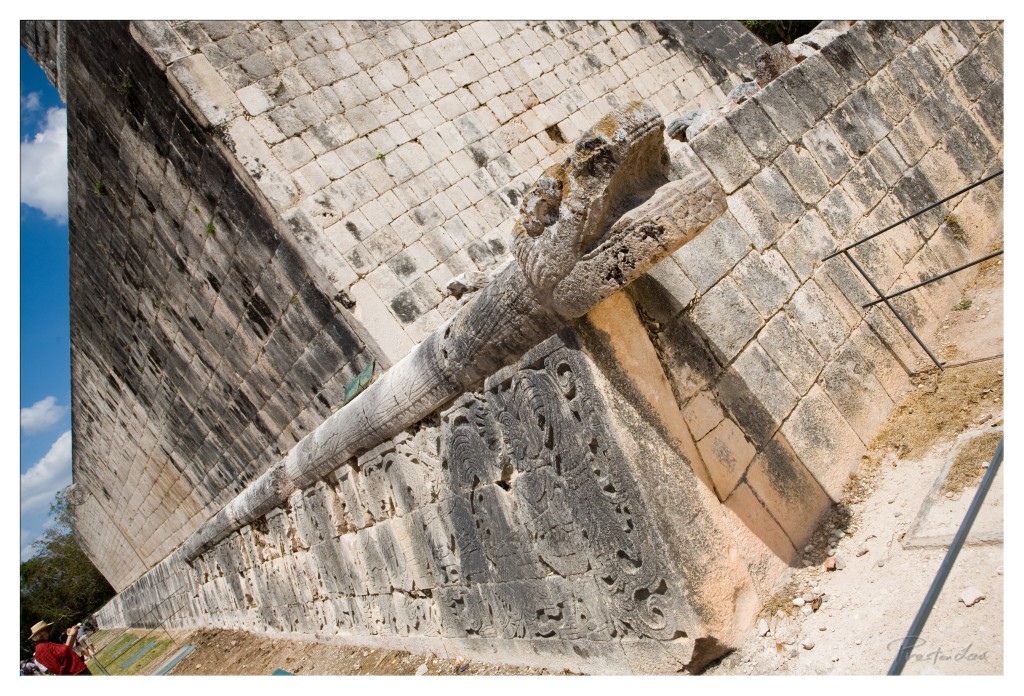

1. Overall Rating (0–10) — 7.0
This photograph captures the imposing presence of an ancient Mayan serpent carving, its weathered stone form emerging from the temple’s stepped facade like a relic of forgotten power. The diagonal composition and dramatic perspective lend a sense of movement and scale, while the contrast between the sunlit stonework and the deep shadows enhances the texture and historical weight of the scene. A slight overexposure in the sky and a cluttered lower-left corner detract from the visual harmony, but the image succeeds in conveying the awe and mystery of a lost civilization.
2. Composition (0–10) — 7.5
The diagonal line of the serpent carving creates a strong visual path, leading the eye from the lower left to the upper right. The tilted perspective adds dynamism, though the framing feels slightly unbalanced due to the inclusion of the crowd and debris in the lower-left corner.
3. Lighting (0–10) — 7.0
Bright, direct sunlight highlights the intricate carvings and emphasizes the texture of the aged stone. The shadows cast by the structure add depth and dimension, though the sky is slightly overexposed, losing detail in the clouds.
4. Color & Tone (0–10) — 6.5
The palette is dominated by warm, earthy tones of weathered limestone, contrasted by the vivid blue of the sky. While the colors are natural and evocative, the saturation feels slightly muted, and the overexposed sky detracts from the overall tonal balance.
5. Creativity (0–10) — 7.0
The choice of a low-angle, tilted perspective gives the image a bold, almost cinematic quality, transforming a historical monument into a dramatic narrative. The focus on the serpent’s form as a symbolic and visual anchor demonstrates strong artistic intent.
6. Technical Quality (0–10) — 7.5
The image is sharp and detailed, with fine texture visible in the stone carvings. The focus is consistent across the main subject, and the exposure is well-managed, aside from the slightly blown-out sky.
7. Emotional Impact (0–10) — 7.5
The photograph evokes a sense of reverence and wonder, inviting the viewer to contemplate the grandeur and mystery of ancient civilizations. The scale and detail of the serpent carving, combined with the bright, open sky, create a moment of awe that resonates emotionally.
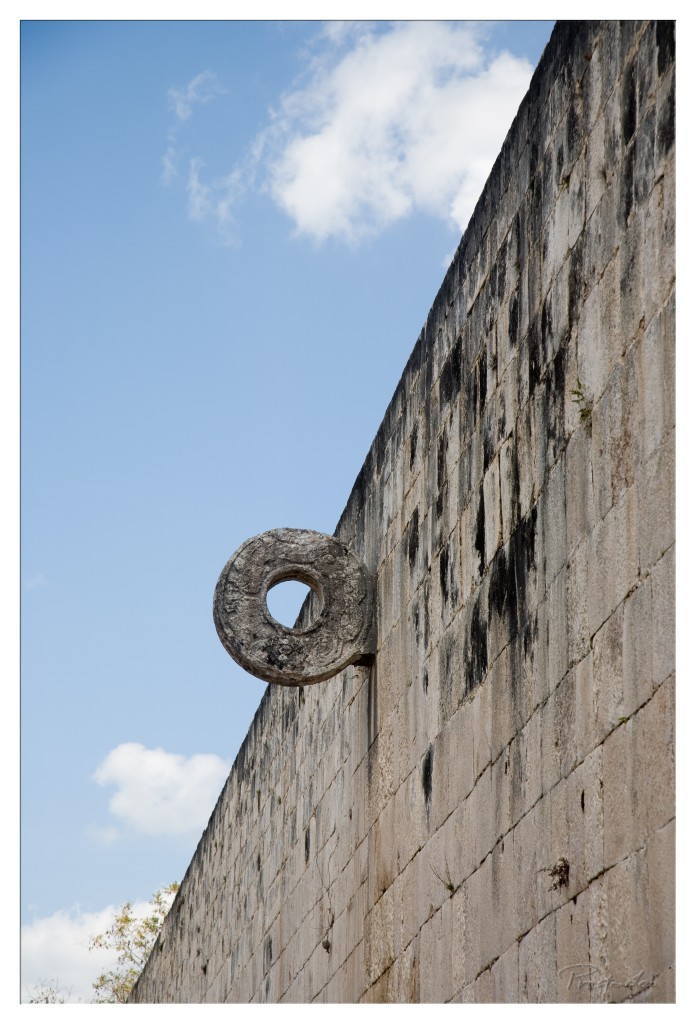

1. Overall Rating (0–10) — 7.5
This photograph captures the quiet majesty of an ancient Mayan structure, where time and stone merge under a vast sky. The weathered stone ring, a relic of ritual and history, stands as a focal point against the clean diagonal of the wall, while the bright blue sky adds a sense of openness and reverence. The image balances historical weight with visual simplicity, though its potential for deeper emotional resonance is slightly restrained by the lack of human presence.
2. Composition (0–10) — 7.0
The diagonal line of the wall creates a strong visual path, leading the eye toward the stone ring, which is placed off-center to enhance balance. The inclusion of sky provides negative space that emphasizes the monument’s isolation and age.
3. Lighting (0–10) — 8.0
Natural daylight illuminates the scene with soft, even light, highlighting the texture of the stone and the subtle weathering without harsh shadows. The bright sky enhances contrast and gives the image a crisp, open quality.
4. Color & Tone (0–10) — 7.5
The palette is restrained—cool grays of the stone against the pale blue sky—creating a harmonious and contemplative tone. The slight warmth in the stone’s hue adds depth and reinforces the sense of age.
5. Creativity (0–10) — 7.0
The choice to frame the ring as a symbolic object against the sky suggests a narrative of endurance and spirituality. While the subject is well-known, the perspective feels fresh and meditative, emphasizing form and history over spectacle.
6. Technical Quality (0–10) — 8.5
Sharp focus and clean detail across the frame ensure the texture of the stone is clearly rendered. The exposure is well-balanced, with no blown highlights or lost shadows.
7. Emotional Impact (0–10) — 7.0
The image evokes a sense of awe and quiet contemplation, inviting the viewer to reflect on the passage of time and the enduring legacy of ancient cultures. The absence of people allows for introspection, though the emotional pull remains subtle rather than overwhelming.
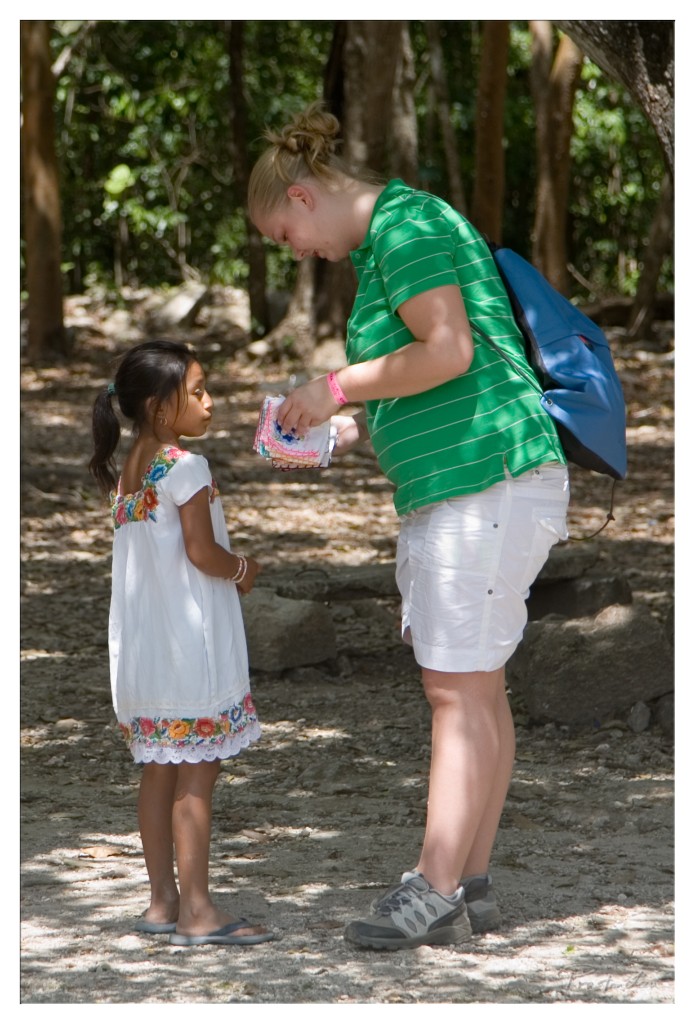

1. Overall Rating (0–10) — 7.0
This photograph captures a tender, cross-cultural moment between two individuals in a sun-dappled forest setting, where the contrast between their attire and surroundings underscores a quiet narrative of connection. The natural lighting and candid interaction lend authenticity to the scene, though the composition’s slight asymmetry and busy background slightly dilute the emotional focus. The image succeeds as a humanistic snapshot, rich in context and warmth, though it stops short of cinematic depth.
2. Composition (0–10) — 6.5
The subjects are positioned off-center, creating a natural flow from the girl to the woman, but the background foliage and uneven ground introduce visual clutter that distracts from the emotional core of the exchange.
3. Lighting (0–10) — 7.0
Soft, dappled sunlight filters through the trees, casting gentle shadows and enhancing the scene’s organic mood. The natural light highlights textures and expressions without harshness, contributing to the image’s authenticity.
4. Color & Tone (0–10) — 7.5
The vibrant green of the woman’s shirt contrasts beautifully with the girl’s white embroidered dress, while the earthy tones of the forest ground provide a warm, natural backdrop. The color palette feels balanced and enhances the cultural and emotional resonance.
5. Creativity (0–10) — 7.0
The image captures a meaningful, unposed moment that transcends mere documentation. The interplay of cultural dress, natural setting, and genuine interaction suggests a deeper story, though the framing remains more observational than interpretive.
6. Technical Quality (0–10) — 7.5
The focus is sharp on the subjects, with clean detail in the textures of clothing and skin. The exposure is well-balanced, preserving detail in both highlights and shadows without noticeable noise.
7. Emotional Impact (0–10) — 8.0
The quiet exchange—marked by the woman’s gentle attention and the girl’s patient gaze—evokes a sense of empathy and shared humanity. The scene feels intimate and respectful, inviting the viewer to reflect on connection across differences.
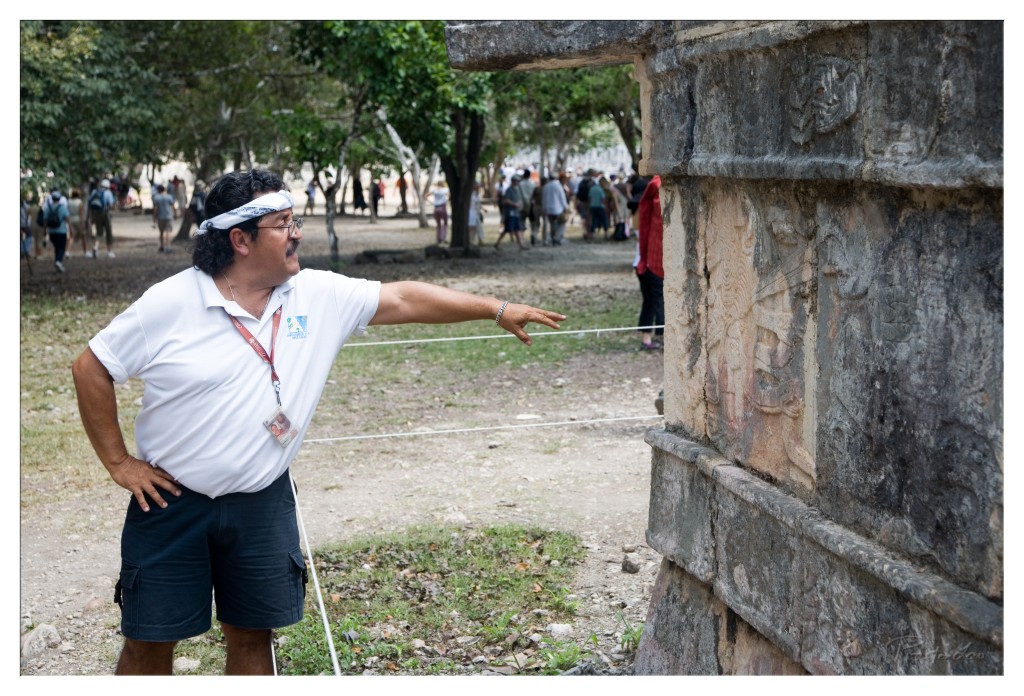

1. Overall Rating (0–10) — 6.8
This photograph captures a moment of cultural storytelling at a Mayan archaeological site, where a guide gestures toward ancient carvings with quiet authority. The scene balances human presence and historical depth, with the weathered stone and background visitors adding context and scale. While the image conveys a sense of place and narrative, the composition’s slight imbalance and flat lighting prevent it from achieving greater visual resonance.
2. Composition (0–10) — 6.0
The guide is positioned off-center, creating a diagonal line that leads the eye toward the carved stone, but the framing feels slightly loose, with too much empty space on the left and a distracting foreground element. A tighter crop would enhance focus on the interaction between guide and artifact.
3. Lighting (0–10) — 5.5
Natural daylight illuminates the scene evenly, but the overhead sun creates flat, untextured shadows and washes out subtle details in the stone carvings. The lack of directional light diminishes the depth and drama of the moment.
4. Color & Tone (0–10) — 6.0
The palette is natural but muted, dominated by earth tones and the white of the guide’s shirt. While the colors feel authentic, they lack vibrancy and contrast, giving the image a slightly dull quality.
5. Creativity (0–10) — 7.0
The image succeeds in capturing a narrative moment—guiding the viewer through history—though it leans more toward documentation than artistic interpretation. The juxtaposition of the modern guide and ancient ruins offers a compelling cultural narrative.
6. Technical Quality (0–10) — 7.5
Sharp focus is maintained on the guide and the stone relief, with good detail in the textures of the carvings and clothing. The image is well-exposed, with no major technical flaws.
7. Emotional Impact (0–10) — 6.5
The photograph evokes a sense of connection to the past, but the emotional pull is tempered by the distance in the framing and the lack of expressive lighting. The viewer is an observer, not a participant.
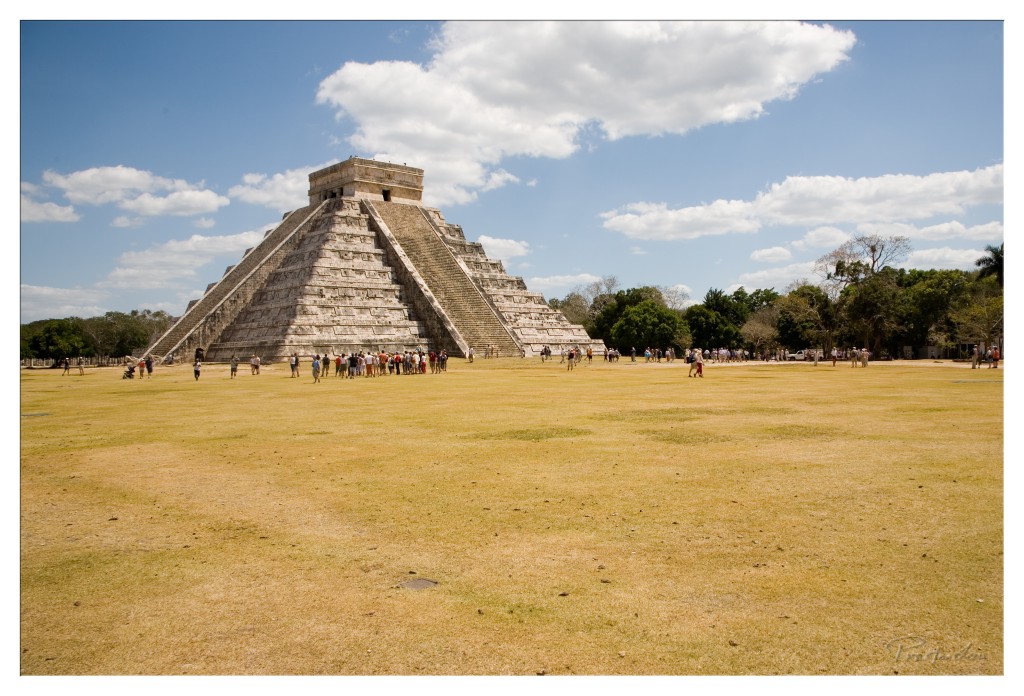

1. Overall Rating (0–10) — 7.0
This photograph captures the grandeur of Chichén Itzá’s El Castillo under a vast, cloud-dappled sky, evoking both the awe of ancient architecture and the quiet hum of modern tourism. The expansive foreground of dry grass draws the eye toward the pyramid, grounding its monumental scale in a human context. While the image effectively conveys the site’s majesty, the slightly flat lighting and lack of dramatic contrast temper its emotional punch, making it more a documentary record than a transcendent visual statement.
2. Composition (0–10) — 7.5
The pyramid is centered and dominates the frame, creating a strong focal point, while the wide-angle perspective emphasizes the scale of the landscape. The scattered tourists provide a sense of scale and activity, though their presence slightly disrupts the monument’s solemnity.
3. Lighting (0–10) — 6.5
Natural daylight is even and bright, with soft shadows that highlight the texture of the stone. The sky’s scattered clouds add visual interest, but the overall lighting lacks depth and contrast, resulting in a somewhat flat and neutral tone.
4. Color & Tone (0–10) — 6.0
The palette is warm and earthy, with golden-brown grass and the gray stone of the pyramid complementing the blue sky. However, the colors feel slightly muted, with a subtle yellow cast that dampens the vibrancy of the scene.
5. Creativity (0–10) — 6.5
The image presents a familiar view with a straightforward, respectful approach, emphasizing scale and context. While not particularly innovative, it effectively communicates the site’s cultural significance and the experience of visiting it.
6. Technical Quality (0–10) — 7.0
The image is sharp and clear, with good focus on the pyramid and consistent detail throughout. The exposure is well-balanced, though the dynamic range could have been better managed to preserve detail in both the sky and the shaded areas.
7. Emotional Impact (0–10) — 6.5
The photograph evokes a sense of wonder and historical continuity, but the distance created by the wide perspective and even lighting prevents a deeper emotional connection. It invites admiration rather than introspection.
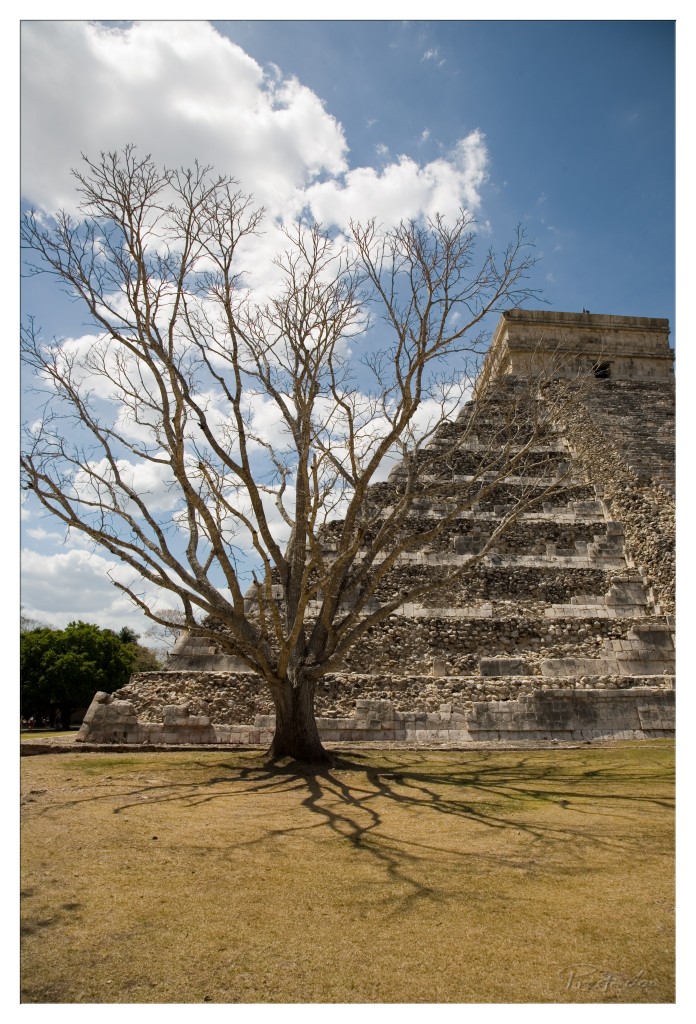

1. Overall Rating (0–10) — 7.5
This photograph captures a striking juxtaposition between ancient stone and organic decay, with the skeletal tree standing as a silent witness to the passage of time. The bold silhouette of the tree against the bright sky creates a dramatic, almost poetic tension with the enduring pyramid, evoking a sense of reverence and impermanence. While the composition is strong and the subject compelling, the slightly overexposed sky and lack of vibrant color temper its visual impact, keeping it from achieving full artistic resonance.
2. Composition (0–10) — 8.0
The tree is centered and dominant, its branches creating a natural frame that draws the eye toward the pyramid. The low-angle perspective enhances the grandeur of the structure, while the diagonal lines of the steps guide the viewer’s gaze upward, creating a balanced and dynamic composition.
3. Lighting (0–10) — 7.0
Natural daylight illuminates the scene clearly, with the sun casting long, defined shadows that add depth and texture. However, the sky is slightly blown out, losing detail in the clouds, which detracts from the overall tonal harmony.
4. Color & Tone (0–10) — 6.5
The palette is dominated by earthy browns and muted greens, with a pale blue sky that feels somewhat washed out. While the contrast between the dark tree and light stone is effective, the lack of rich saturation limits the image’s emotional warmth.
5. Creativity (0–10) — 8.0
The image presents a powerful metaphor—nature reclaiming history—through a compelling visual narrative. The choice to feature the bare tree in front of the pyramid suggests a story of resilience and time, making the photograph more than a simple architectural portrait.
6. Technical Quality (0–10) — 7.5
The focus is sharp on the tree and pyramid, with good clarity in the textures of the stone and bark. The exposure is mostly well-handled, though the overexposed sky indicates a minor technical limitation.
7. Emotional Impact (0–10) — 7.0
There is a quiet solemnity to the image that invites reflection on time, memory, and the enduring presence of both nature and human achievement. The starkness of the tree and the vastness of the sky evoke a sense of awe and melancholy.
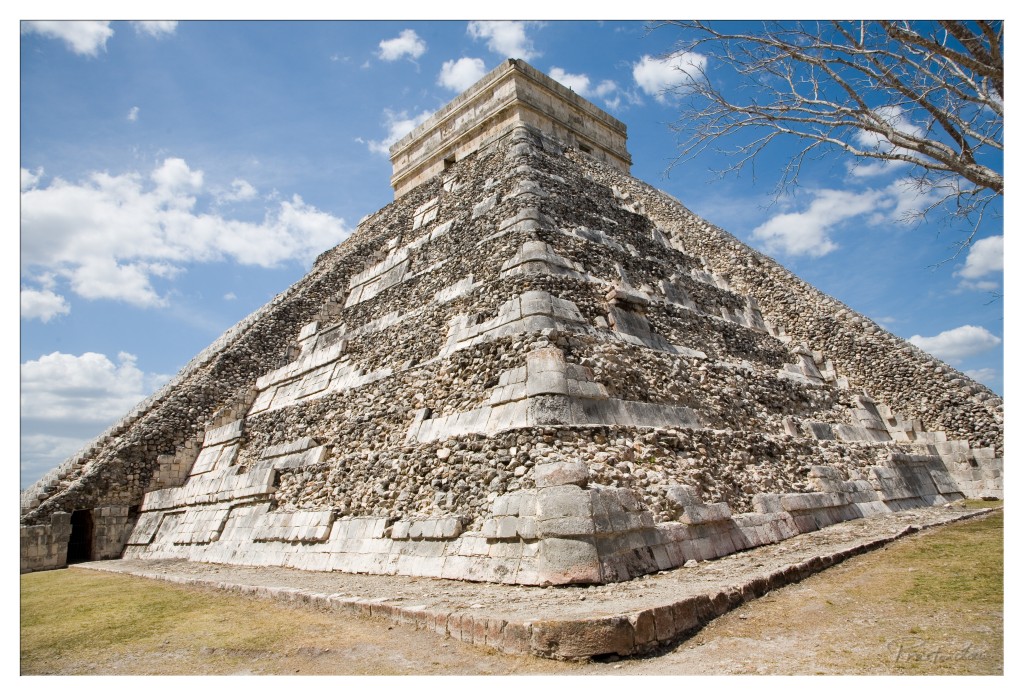

1. Overall Rating (0–10) — 8.0
This photograph captures the imposing grandeur of Chichén Itzá’s El Castillo with striking clarity and reverence for its historical weight. The low-angle perspective emphasizes the pyramid’s monumental scale, while the contrast between the ancient stone and the vibrant blue sky lends a sense of timelessness. The inclusion of bare tree branches in the upper right adds a subtle natural frame, grounding the image in its environment. While the composition is strong, the lack of human presence keeps the scene from fully conveying the scale of the site’s cultural significance.
2. Composition (0–10) — 8.0
The low-angle shot creates a dynamic sense of verticality and dominance, drawing the eye upward along the stepped structure. The diagonal lines of the pyramid’s terraces guide the viewer’s gaze toward the summit, while the bare tree branches in the top-right corner add depth and balance. The framing is slightly off-center, which enhances visual interest without disrupting harmony.
3. Lighting (0–10) — 8.5
Natural daylight illuminates the pyramid with even, bright illumination, highlighting the texture and weathering of the stone. The sunlight enhances the contrast between the sunlit surfaces and the shadows in the crevices, adding dimension. The clear sky and scattered clouds contribute to a balanced exposure and a sense of openness.
4. Color & Tone (0–10) — 8.0
The palette is dominated by the warm, earthy tones of the limestone and the deep blue of the sky, creating a visually striking contrast. The colors are rich and well-saturated, with the pale gray of the stone complementing the vibrant sky. The overall tone feels authentic and grounded, reinforcing the historical gravitas of the scene.
5. Creativity (0–10) — 7.5
The photograph successfully captures the iconic nature of the site with a clear artistic vision. The low-angle perspective and framing choices demonstrate intentionality, emphasizing the pyramid’s scale and spiritual resonance. While the subject is familiar, the composition and lighting elevate it beyond a mere documentary shot into a contemplative portrait of ancient power.
6. Technical Quality (0–10) — 9.0
The image is sharp and detailed, with excellent focus across the frame. The exposure is well-managed, preserving detail in both highlights and shadows. The camera’s resolution renders the texture of the stone with clarity, and there is minimal noise, indicating strong technical execution.
7. Emotional Impact (0–10) — 8.0
The photograph evokes a sense of awe and reverence, inviting the viewer to reflect on the ingenuity and endurance of the Maya civilization. The scale and stonework inspire wonder, while the open sky and quiet setting suggest a moment of stillness and connection to the past. The emotional resonance is strong, though the absence of people or activity keeps it slightly detached from the human experience of visiting the site.
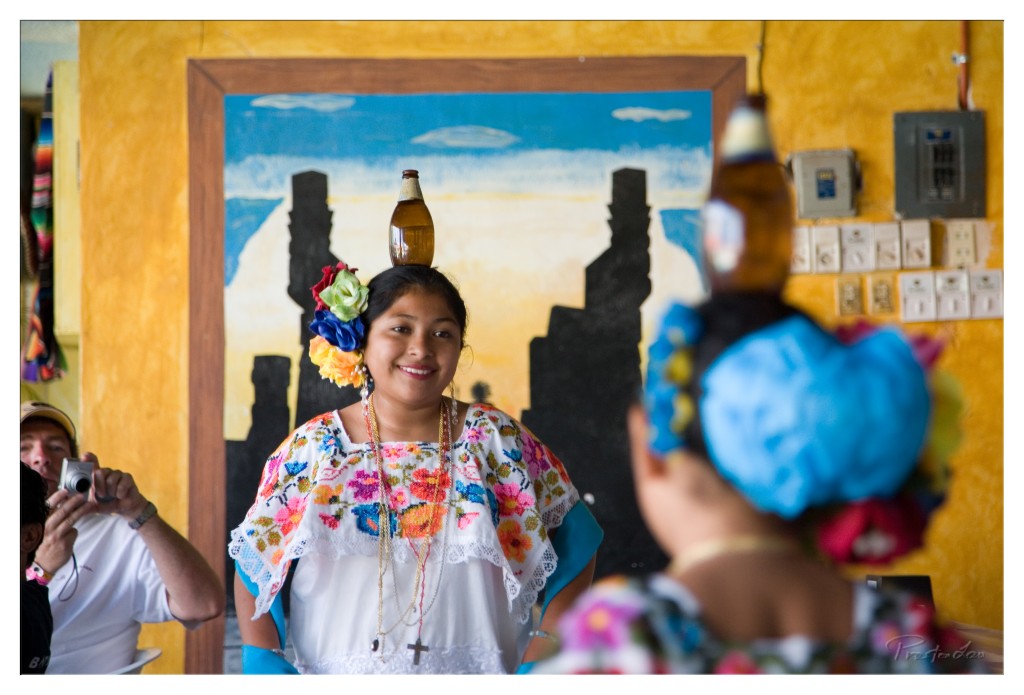

1. Overall Rating (0–10) — 7.5
This photograph captures a vibrant cultural moment with warmth and authenticity, centering on a woman in traditional attire balancing a bottle with quiet confidence. The interplay of colors, candid expression, and layered depth—enhanced by the mirror and background activity—gives the image a lively, documentary charm. While the cluttered background slightly distracts from the subject’s poise, the scene's emotional richness and cultural specificity make it compelling and memorable.
2. Composition (0–10) — 7.0
The central figure is well-framed, with the mirror and foreground elements creating depth and narrative context. The balance is slightly disrupted by the photographer in the left foreground, which adds candidness but also competes for attention.
3. Lighting (0–10) — 6.5
Natural light from the side illuminates the subject’s face and clothing, creating soft highlights and gentle shadows. The indoor setting results in uneven lighting, with some areas slightly overexposed, but the overall effect maintains warmth and clarity.
4. Color & Tone (0–10) — 8.0
The rich, saturated hues of the floral blouse and headpiece contrast beautifully against the yellow wall and blue accents in the painting. The warm tone enhances the festive, celebratory mood, with a cohesive palette that draws the eye to the subject.
5. Creativity (0–10) — 7.5
The inclusion of the mirror and the reflection of the bottle on the head creates a layered, self-referential narrative. The candid moment, combined with cultural elements, feels both authentic and artistically staged, offering a glimpse into tradition with a sense of playful performance.
6. Technical Quality (0–10) — 7.5
The focus is sharp on the central subject, with clear detail in the embroidery and facial expression. The depth of field is appropriate, keeping the foreground and background slightly soft to emphasize the main figure. The image is well-exposed, with no major technical flaws.
7. Emotional Impact (0–10) — 8.0
The woman’s warm smile and confident expression convey pride and joy, creating an immediate emotional connection. The viewer is drawn into the moment, sensing both the cultural significance and the personal warmth of the scene.
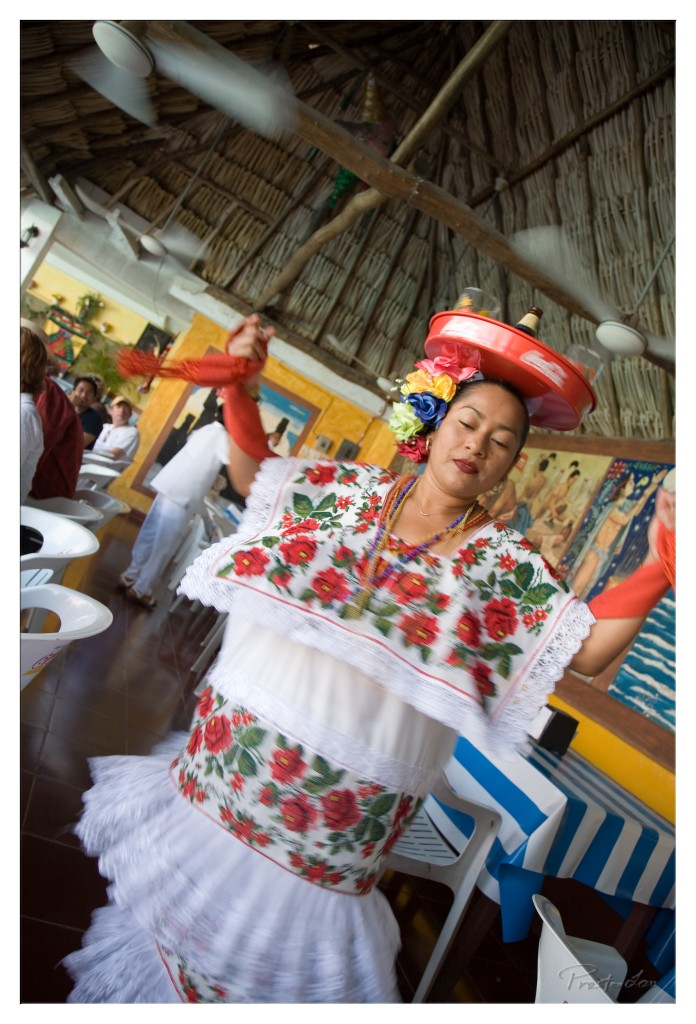

1. Overall Rating (0–10) — 7.0
This photograph captures the vibrant energy of a traditional cultural performance, with a dancer mid-movement exuding grace and joy. The dynamic blur of motion conveys the rhythm of the dance, while the richly detailed costume and setting ground the image in authenticity. Though the composition feels slightly unbalanced due to the tilted frame, the emotional warmth and cultural richness elevate the image into a compelling visual narrative.
2. Composition (0–10) — 6.0
The diagonal tilt adds energy but disrupts visual stability. The dancer is well-placed, but the surrounding clutter and blurred ceiling fans distract from the focal point.
3. Lighting (0–10) — 6.5
Natural light filters through the open structure, creating soft shadows and a warm, ambient glow. The motion blur softens the light’s impact, enhancing the sense of movement but reducing detail.
4. Color & Tone (0–10) — 8.0
The bold reds of the flowers and headpiece contrast beautifully with the white lace and straw textures. The warm yellow walls and blue-striped tablecloth add depth and cultural authenticity to the palette.
5. Creativity (0–10) — 8.0
The use of motion blur to convey dance rhythm is inventive and expressive. The integration of cultural elements—costume, setting, and performance—makes the image both visually engaging and narratively rich.
6. Technical Quality (0–10) — 7.0
The dancer remains sharp despite the motion blur, indicating a well-chosen shutter speed. Focus is accurate, though some background elements are slightly soft due to depth of field and motion.
7. Emotional Impact (0–10) — 8.0
The dancer’s serene expression and cultural pride evoke a deep sense of connection to tradition. The viewer feels drawn into the moment, sharing in the joy and authenticity of the performance.
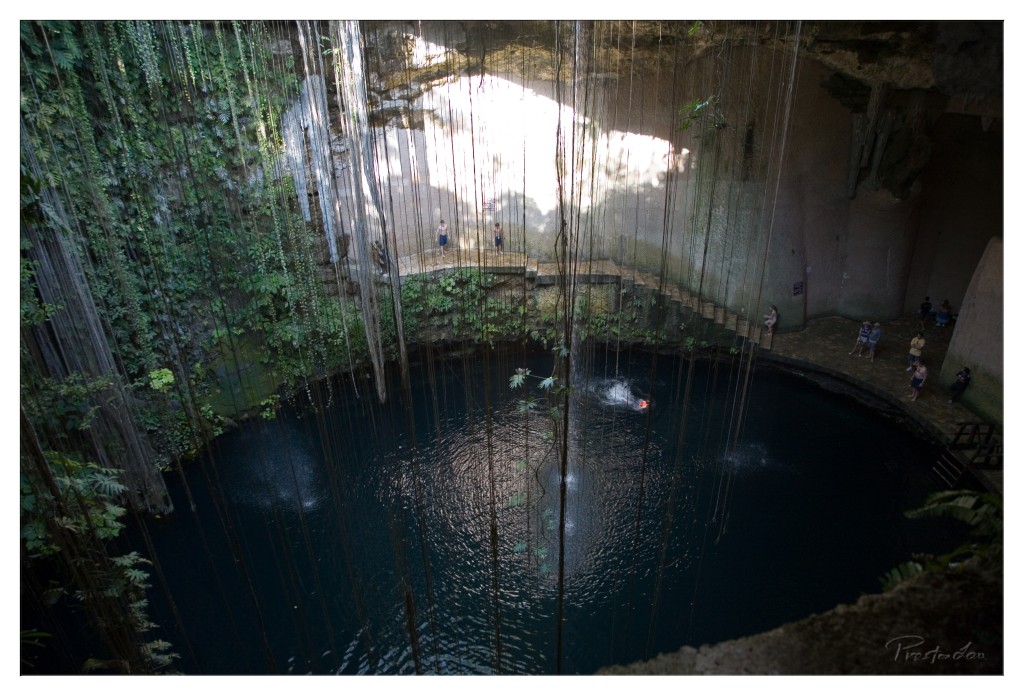

1. Overall Rating (0–10) — 7.0
This photograph captures the mystical stillness of a cenote, where natural beauty and human presence intertwine in quiet harmony. The cascading roots and dappled sunlight create a dreamlike atmosphere, evoking both awe and serenity. While the image effectively conveys the location’s otherworldly charm, the composition’s slight imbalance and underexposed foreground limit its visual power.
2. Composition (0–10) — 6.5
The high-angle perspective emphasizes the depth of the cenote, but the heavy root strands in the foreground disrupt visual flow. The placement of people on the far side creates a sense of scale, though the framing feels slightly off-center and unbalanced.
3. Lighting (0–10) — 7.5
The interplay of light and shadow is striking—sunlight streams through the opening above, illuminating the water and walls while leaving the foreground in deep shadow. This contrast enhances the scene’s dramatic, almost sacred mood, though the overexposed upper portion slightly detracts from the overall balance.
4. Color & Tone (0–10) — 7.0
The deep, dark blue of the water contrasts beautifully with the earthy greens and muted stone tones. The natural palette feels authentic and immersive, though the lack of vibrant saturation tempers the image’s visual impact.
5. Creativity (0–10) — 7.5
The photographer captures a rare moment of natural wonder with a strong sense of place. The use of the cenote’s vertical roots as a framing device adds a poetic layer, transforming a scenic view into a contemplative narrative.
6. Technical Quality (0–10) — 7.5
Sharp focus is maintained across the image, with clear detail in both the water and the surrounding rock. The exposure is well-handled, though the bright spot at the top suggests slight overexposure in the highlights.
7. Emotional Impact (0–10) — 7.0
The image evokes a deep sense of tranquility and reverence for nature’s hidden wonders. The presence of people adds a subtle human element, inviting the viewer to imagine themselves in this serene, sacred space.
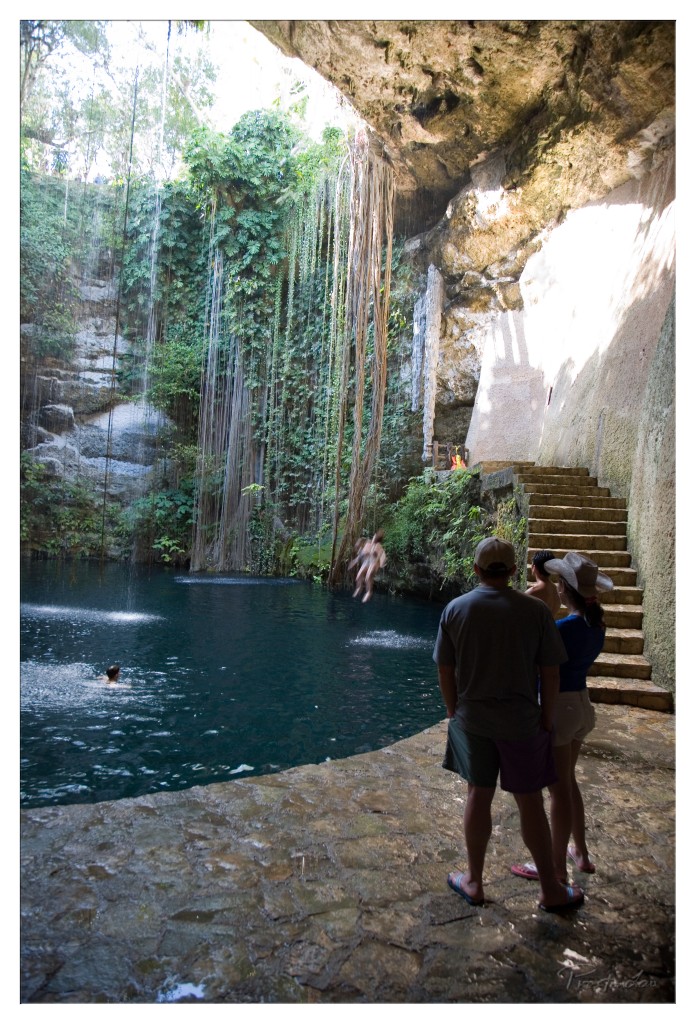

1. Overall Rating (0–10) — 7.0
This photograph captures the serene majesty of a natural cenote, where human presence harmonizes with the raw beauty of the underground spring. The interplay of light, water, and stone evokes a sense of sacred stillness, while the dynamic moment of someone diving adds life and movement. Though the composition is slightly unbalanced by the foreground figures, the image succeeds in conveying both the scale of the landscape and the quiet awe of the moment.
2. Composition (0–10) — 6.0
The foreground figures anchor the scene but partially obscure the view, creating a slight visual clutter. The diagonal line of the stairs and the cascading vines guide the eye toward the center, but the framing feels slightly off-center, reducing compositional harmony.
3. Lighting (0–10) — 7.5
Natural light filters through the cave opening, creating a soft, diffused glow that enhances the textures of the stone and water. The contrast between the sunlit rim and the shadowed interior adds depth and atmosphere.
4. Color & Tone (0–10) — 7.0
The deep emerald tones of the water contrast beautifully with the earthy browns and greens of the cave walls and foliage. The overall palette is rich and natural, with a slightly cool tone that reinforces the tranquil mood.
5. Creativity (0–10) — 7.5
The image captures a rare moment of human interaction with a natural wonder, blending documentary realism with a sense of place. The inclusion of the diving figure introduces narrative and movement, elevating the scene beyond mere landscape.
6. Technical Quality (0–10) — 8.0
The image is sharp and well-exposed, with clear detail in both the foreground and background. The focus is consistent, and the dynamic range is well-managed, preserving detail in both the bright sky and dark water.
7. Emotional Impact (0–10) — 7.5
The photograph evokes a sense of wonder and peaceful adventure, inviting the viewer to imagine the cool plunge into the cenote and the quiet reverence of standing at its edge. The emotional resonance lies in the balance between nature’s grandeur and human curiosity.
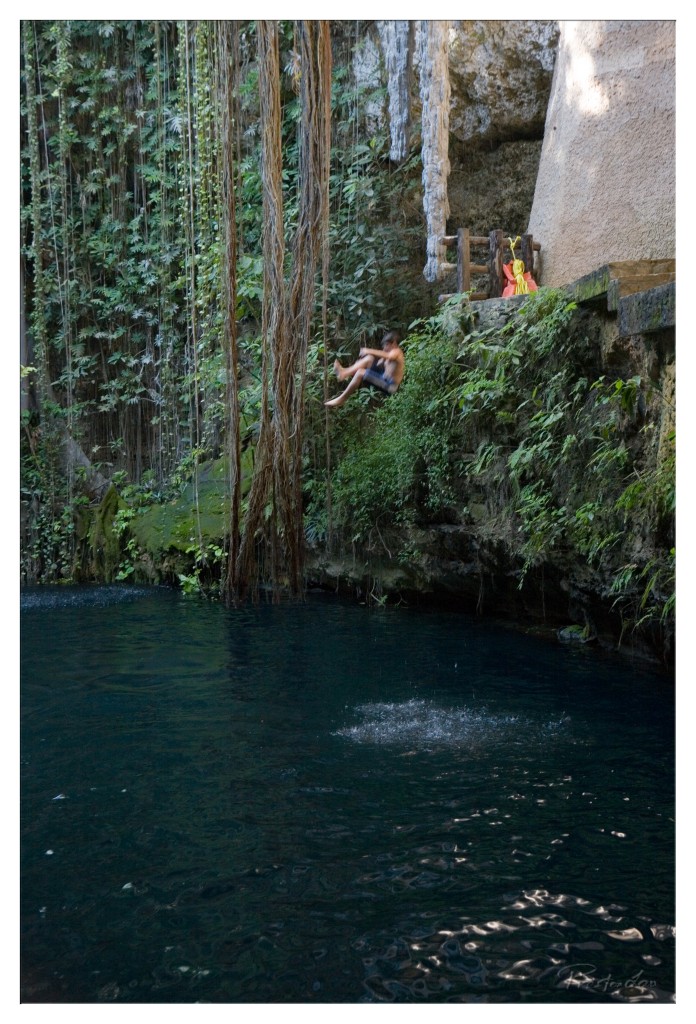

1. Overall Rating (0–10) — 7.5
This photograph captures a moment of serene adventure, where human scale meets the grandeur of a natural cenote. The interplay of shadow and light, combined with the lush greenery and deep water, evokes a sense of mystery and timelessness. While the image is visually compelling, the slightly awkward framing and muted tones keep it from achieving full artistic resonance.
2. Composition (0–10) — 6.5
The subject is placed off-center, creating a dynamic tension, but the composition feels slightly unbalanced due to the heavy foliage on the left and the large blank wall on the right. A tighter crop could enhance focus and visual flow.
3. Lighting (0–10) — 7.0
Natural light filters through the canopy, casting soft shadows and highlighting the textures of the rock and vines. The contrast between the illuminated cliff and the dark water adds depth, though some areas of the frame are underexposed.
4. Color & Tone (0–10) — 6.5
The dominant cool tones of the water and greenery create a tranquil mood, but the overall palette feels slightly flat and desaturated, reducing the vibrancy of the scene.
5. Creativity (0–10) — 7.0
The image successfully conveys the quiet drama of a person about to leap into the unknown, merging human action with natural wonder. The choice of a cenote setting adds cultural and geological intrigue, lending a narrative depth.
6. Technical Quality (0–10) — 7.5
The image is sharp and clear, with good detail in the textures of the rock, vines, and water. The focus is well-managed, and the exposure is balanced despite the challenging lighting conditions.
7. Emotional Impact (0–10) — 7.0
The photograph evokes a sense of calm daring and connection to nature, inviting the viewer to imagine the cool splash and the stillness of the water below. The solitude of the figure enhances the emotional weight of the moment.
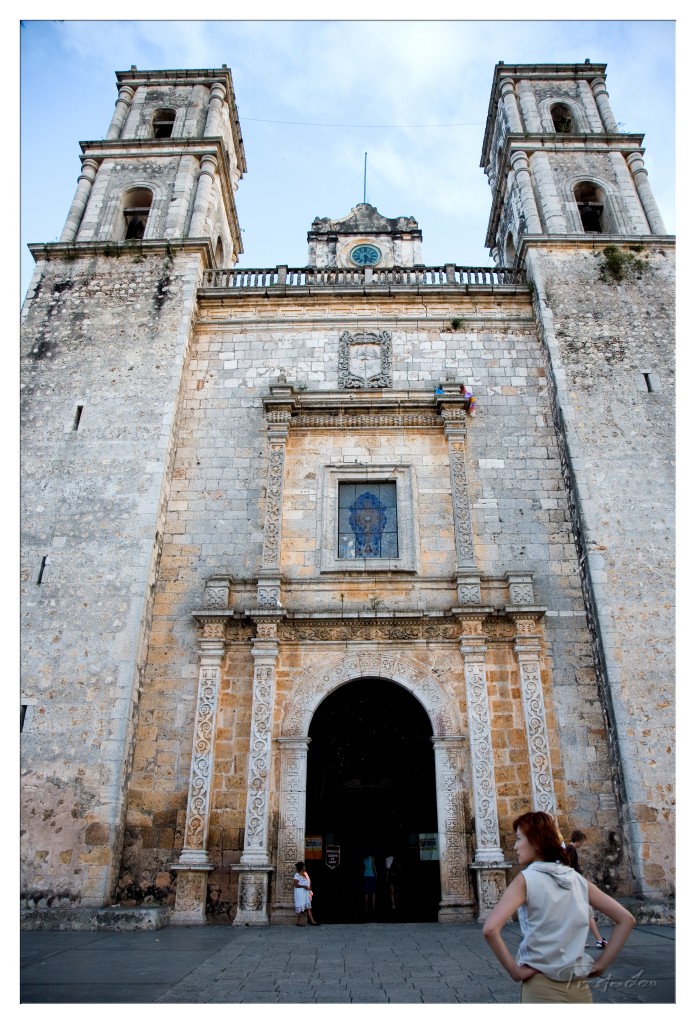

1. Overall Rating (0–10) — 7.0
This photograph captures the imposing grandeur of a historic church, its weathered stone facade speaking to centuries of cultural and religious significance. The low-angle perspective enhances the building’s verticality, while the presence of a few figures adds scale and a sense of lived-in history. Though the composition is strong, the slightly awkward framing and overcast lighting prevent it from achieving a more dramatic or emotionally resonant impact.
2. Composition (0–10) — 7.5
The low-angle shot emphasizes the church’s towering structure, with the two bell towers framing the central entrance. The inclusion of the woman in the foreground adds depth and scale, though her placement slightly disrupts the symmetry of the composition.
3. Lighting (0–10) — 6.0
The soft, diffused light from the overcast sky minimizes harsh shadows, allowing architectural details to be visible but lending a flat, muted quality to the image. The sky’s brightness creates a slight contrast with the darker stone, but the lack of strong directional light reduces depth and mood.
4. Color & Tone (0–10) — 6.5
The palette is dominated by muted grays and beiges of the aged stone, punctuated by the subtle blue of the stained glass and the warm tone of the woman’s clothing. The tonal range is moderate, with a slight coolness in the sky that contrasts with the earthy tones of the building.
5. Creativity (0–10) — 7.0
The choice to photograph from a low angle and include human figures grounds the monumental architecture in everyday life, offering a narrative of scale and continuity. The framing suggests a personal encounter with history rather than a purely architectural study.
6. Technical Quality (0–10) — 8.0
The image is sharp and detailed, with clear textures in the stonework and well-defined edges around the archway and columns. Focus is consistent across the frame, and there is minimal noise despite the natural lighting conditions.
7. Emotional Impact (0–10) — 6.5
The photograph evokes a sense of reverence and timelessness, inviting the viewer to contemplate the endurance of tradition and faith. The human presence adds a quiet intimacy, but the subdued lighting and composition keep the emotional resonance restrained.
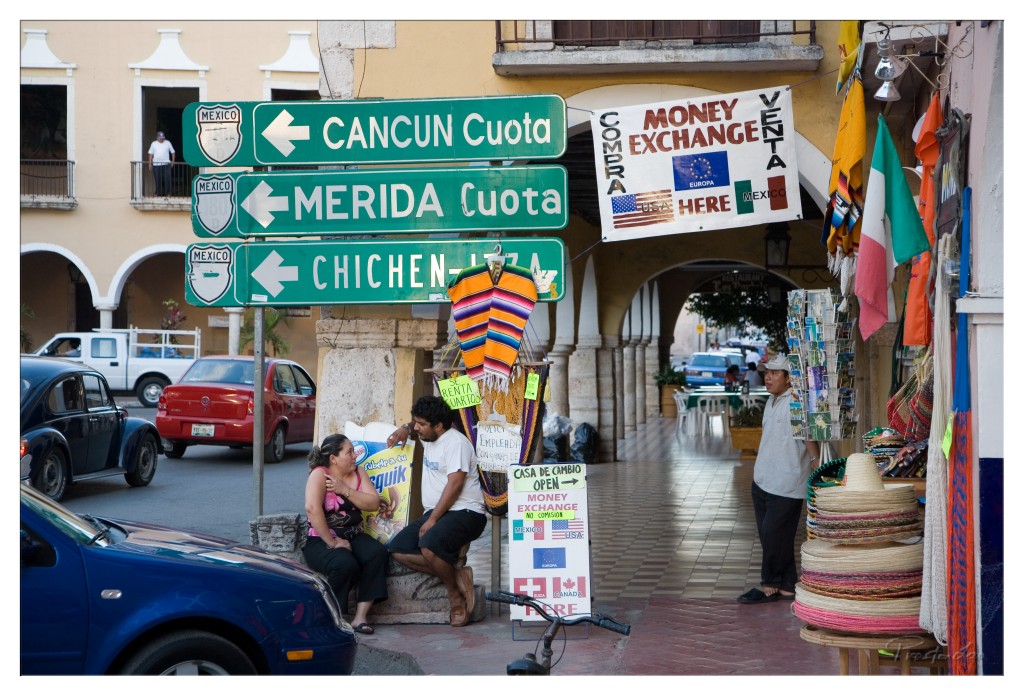

1. Overall Rating (0–10) — 7.0
This photograph captures the vibrant pulse of a Mexican street scene, blending everyday life with cultural and commercial markers in a layered, authentic tableau. The juxtaposition of directional signs, currency exchange signage, and local vendors creates a narrative of movement and transition, while the warm tones and casual human interaction lend a sense of lived-in realism. The image is rich in detail and context, though the visual clutter slightly undermines its compositional clarity.
2. Composition (0–10) — 6.5
The frame is densely packed with elements—signs, people, vehicles—creating a busy, almost chaotic arrangement. The diagonal flow of the street signs and the archway guide the eye into the depth of the scene, but the central figures are slightly off-center, and the foreground car cuts into the frame, disrupting balance.
3. Lighting (0–10) — 7.0
Natural daylight illuminates the scene evenly, with soft shadows suggesting midday light. The brightness enhances the vivid colors of the textiles and flags, while the overhead arches create subtle contrast and depth, giving the image a sense of place and time.
4. Color & Tone (0–10) — 7.5
The palette is rich and varied, with the green of the signs, the red of the cars, and the warm earth tones of the hats and textiles creating a dynamic visual harmony. The saturation is strong without appearing oversaturated, and the overall warmth enhances the tropical, inviting atmosphere.
5. Creativity (0–10) — 7.0
The image is conceptually strong, capturing a moment where travel, commerce, and daily life intersect. The layered signs and cultural artifacts—flags, sombreros, currency exchange—tell a story of globalization and local identity, making the photograph more than a snapshot; it’s a cultural document.
6. Technical Quality (0–10) — 7.5
Sharp focus across the frame allows for clear detail in both foreground and background elements. The exposure is well-balanced, with no blown-out highlights or lost shadows, and the camera’s resolution captures fine textures in the architecture and merchandise.
7. Emotional Impact (0–10) — 6.5
The image evokes a sense of curiosity and connection to a place in motion. The relaxed posture of the seated couple and the casual presence of the vendor suggest a rhythm of daily life, inviting viewers to imagine the sounds, conversations, and stories unfolding beyond the frame. It feels authentic, though the visual density may slightly dilute the emotional resonance.
Loading map...